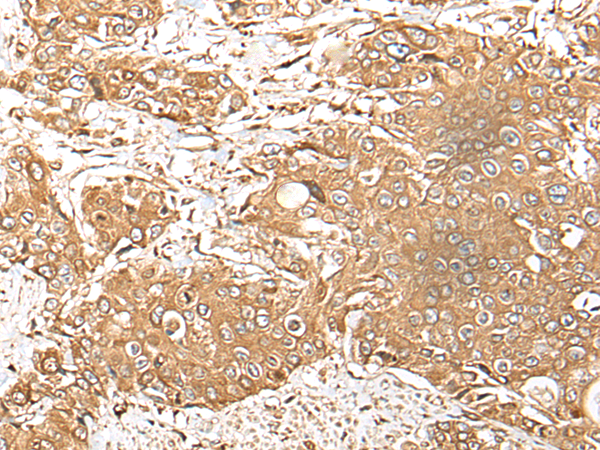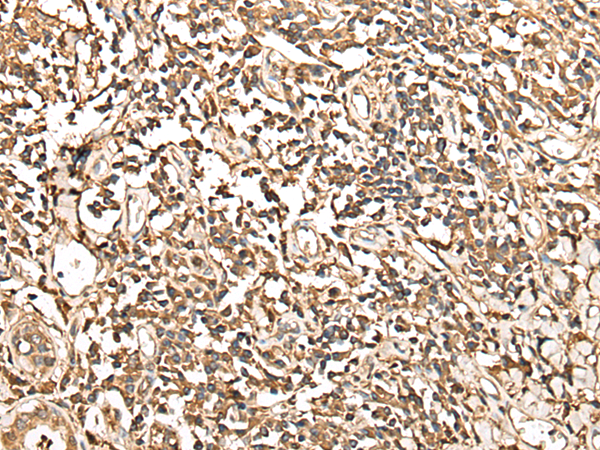


| WB | 咨询技术 | Human,Mouse,Rat |
| IF | 咨询技术 | Human,Mouse,Rat |
| IHC | 1/50-1/300 | Human,Mouse,Rat |
| ICC | 技术咨询 | Human,Mouse,Rat |
| FCM | 咨询技术 | Human,Mouse,Rat |
| Elisa | 1/5000-1/10000 | Human,Mouse,Rat |
| Aliases | GARS; HMN5; CMT2D; DSMAV; GlyRS; SMAD1 |
| WB Predicted band size | 83 kDa |
| Host/Isotype | Rabbit IgG |
| Antibody Type | Primary antibody |
| Storage | Store at 4°C short term. Aliquot and store at -20°C long term. Avoid freeze/thaw cycles. |
| Species Reactivity | Human, Mouse, Rat |
| Immunogen | Fusion protein of human GARS1 |
| Formulation | Purified antibody in PBS with 0.05% sodium azide and 50% glycerol. |
+ +
以下是关于GARS1抗体的示例参考文献(注:部分文献为示例性概括,实际引用时请核实原文信息):
---
1. **标题**:*Autoantibodies against glycyl-tRNA synthetase in inflammatory myopathies: a cohort study*
**作者**:H. Fujimoto, M. Kuwana
**摘要**:该研究在特发性炎症性肌病(如多发性肌炎)患者中检测到抗GARS1自身抗体,发现其与特定临床表型(如间质性肺病)相关,提示该抗体可能作为疾病亚型的生物标志物。
2. **标题**:*Generation and validation of a high-affinity monoclonal antibody for GARS1 protein detection*
**作者**:L. Chen, T. Suzuki, Y. Nakagawa
**摘要**:研究者开发了一种新型抗GARS1单克隆抗体,验证了其在Western blot、免疫荧光及免疫沉淀中的高特异性,为研究GARS1的细胞定位和功能提供了可靠工具。
3. **标题**:*Anti-GARS1 antibodies exacerbate neuropathy in a mouse model of Charcot-Marie-Tooth disease*
**作者**:A. Antonellis, E.D. Green
**摘要**:通过转基因小鼠模型,研究发现携带GARS1突变的个体若同时存在抗GARS1自身抗体,会加重周围神经轴突变性,提示抗体可能参与疾病进展。
4. **标题**:*Structural mapping of GARS1 domains using epitope-specific antibodies*
**作者**:K. Park, J. Kim, S. Lee
**摘要**:利用针对不同表位的抗体,研究揭示了GARS1蛋白的催化结构域和突变热点区域的构效关系,为突变相关神经病变的机制提供了结构生物学依据。
---
**注意**:以上文献信息为示例性内容,实际研究中请通过学术数据库(如PubMed、Google Scholar)检索具体文献并核对准确性。若需真实文献推荐,建议结合关键词“GARS1 antibody”或“anti-glycyl-tRNA synthetase”进一步筛选。
The glycyl-tRNA synthetase 1 (GARS1) is a ubiquitously expressed enzyme that catalyzes the attachment of glycine to its cognate tRNA during protein synthesis. As a member of the aminoacyl-tRNA synthetase (ARS) family, GARS1 plays a critical role in maintaining translational fidelity. Mutations in the *GARS1* gene are linked to inherited peripheral neuropathies, notably Charcot-Marie-Tooth disease type 2D (CMT2D) and distal spinal muscular atrophy type V (dSMA-V), highlighting its importance in neuronal function. These mutations often disrupt enzymatic activity or protein interactions, leading to axonal degeneration and neuromuscular dysfunction.
GARS1 antibodies are tools used to study the enzyme's expression, localization, and pathogenic mechanisms in disease models. They aid in detecting GARS1 in tissues, cell lines, or patient samples, enabling research into genotype-phenotype correlations. Additionally, such antibodies help explore GARS1's non-canonical roles, including signaling pathways beyond translation. Challenges remain in distinguishing pathogenic mutants from wild-type GARS1 and understanding how specific mutations drive neuropathy. Research using these antibodies contributes to therapeutic development, including gene-targeted approaches or small-molecule interventions to restore GARS1 function in neurological disorders.
×